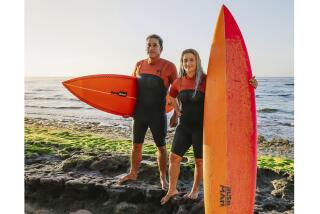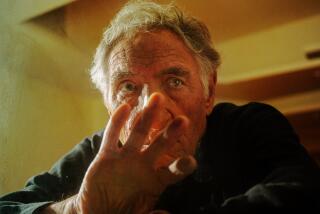Terry ‘Tubesteak’ Tracy dies at 77; model for Big Kahuna in ‘Gidget’
- Share via
In 1956, Terry “Tubesteak” Tracy, freshly fired from his job at a downtown insurance company, bid goodbye to the 9-to-5 life and headed for the Malibu shore, where he built himself a shack out of wood scraps and palm fronds and sailed into surfing history.
He was, according to surfing historian Matt Warshaw, a decent surfer, but his ticket to glory wasn’t what he did on a board: It was the aesthetic he embraced. Tracy, better known by the nickname “Tubesteak,” was the personification of the rebellious surf subculture that emerged in California in the late 1950s. He was an anti-authoritarian sage in Wayfarer shades and Madras shorts who made bumming on the beach the essence of cool and an irresistible draw for a girl he called Gidget.
An impresario of Malibu beach when it became the most famous surf break in the world, Tracy died Wednesday at his home in San Clemente of complications of diabetes, said his wife, Phyllis. He was 77.
Although he hadn’t ridden the waves in decades, he was revered as an elder statesman of the surfing world, known in later years for the articles he wrote about the crazy parties and beach pranks that became, Surfer’s Journal publisher Steve Pezman wrote this week in a tribute, “anthems to true surfer style.”
The burly bohemian was holding court outside his Malibu shack in the summer of ’56 when a petite teenager named Kathy Kohner wandered by to borrow a surfboard. Five feet tall and 95 pounds, she reminded Tracy of a teensy girl he once met who had been dubbed Gidget, a mash up of “girl” and “midget.” Inspired by the memory, Tracy later said, he called Kohner that — and the name stuck.
When she told her screenwriter father, Frederick Kohner, about the characters she met on the beach, he turned her stories into a novel, “Gidget, the Little Girl with Big Ideas,” published in 1957.
With the release of the 1959 movie, which starred Sandra Dee as the title character and featured Cliff Robertson as a Tracy-inspired shack-dweller named the Big Kahuna, the surfer lifestyle blazed by Tracy and others exploded into popular culture, giving rise to a slew of sequels (“Gidget Goes Hawaiian,” “Gidget Goes to Rome”), musical groups like the Beach Boys, and a popular 1960s sitcom starring Sally Fields as the fun-and-sun-loving pixie.
Although Tracy claimed the distinction, Kohner isn’t sure he was the first surfer to call her Gidget. “I didn’t write it down in my diary, so it’s up for grabs,” she said Wednesday. But what is certain, she said, was that “we’ve lost one of the legends of Malibu. He just embodied surf culture.” And unlike other Malibu regulars, he was kind to newcomers.
“Some of the surfers would bury my surfboard or disconnect the distributor in my car,” recalled Kohner, who goes by her married name Zuckerman, “but Terry was always nice to me. I wanted to hang out at Tubesteak’s shack, not at the pit with the hard-core surfers.”
The son of a Shell oil company worker and a housewife, Tracy was born in Los Angeles on March 13, 1935, and graduated from Cathedral High School. A football player of some promise, he attended Santa Monica City College but, unable to resist the allure of the beach, dropped out after a year.
At 15 he was surfing regularly at San Onofre State Beach, where he met Miki Dora, whose graceful surfing style would make him a hero of the sport.
According to Tracy’s wife, he received his colorful nickname from Dora, who died of cancer at 67 in 2002. Tracy gave various explanations for the name. Sometimes he said Tubesteak was slang for a hotdog, which in turn is slang for a showoff, which Tracy often was. Other times he said the name came from his working at a restaurant called Tubesteak’s.
Regardless of the origin, it was, say those who knew him, the perfect moniker for a surfing chieftain with a wry sense of humor and flair for performance
In his book “The History of Surfing,” Warshaw described how every afternoon at Malibu Tracy paddled into the crowded surf and waited for one long wave. Then he would mount his board and, with onlookers whistling and shouting their approval, strike a series of exaggerated poses, including a stiff-legged move with arms outstretched that he called the Royal Hawaiian.
Upon returning to the sand, “grinning like Falstaff,” Warshaw wrote, “Tracy would stop and look up at his still-cheering audience, lift his chin and grandly raise a hand in acknowledgment.”
When his show was over, he resumed his perch by the shack, where he plotted further antics. Most memorably, he once dressed up as Father Junipero Serra and rode down the beach on a donkey.
He left Malibu in the late 1950s after a lifeguard berated him for lighting a fire to melt wax for his board. By then he had a family to support and held a number of occupations over the years, including driving a truck and selling real estate.
He stopped surfing in 1980 when he developed a painful swelling in one of his feet. That was just as well, he told The Times several years later, when he moved to San Clemente, because “people over 40 who surf look stupid.” He made San Onofre beach his hangout.
“Surfing didn’t have a sense of humor until Terry came along,” Warshaw said this week. “What Terry recognized was that having a good time was the point, not the byproduct, of surfing at the beach. He was the guy who was having the best time.”
In addition to his wife of 54 years, Tracy is survived by seven children, Pamela Guinn, Jennifer Tracy, Jocelyn Graham, and Patrick, Michael, Jonathan and Moe Tracy, all of whom he taught to surf, and eight grandchildren.
More to Read
Start your day right
Sign up for Essential California for the L.A. Times biggest news, features and recommendations in your inbox six days a week.
You may occasionally receive promotional content from the Los Angeles Times.







